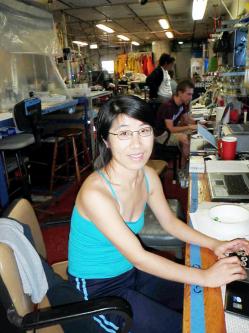Karen StamieszkinI have been sitting at the computer console for hours, guiding the rosette, with the help of the winch operator, down to around six kilometers below the sea’s surface. The main lab where one sits while “on console” is freezing cold and fluorescently lit: not a cozy situation. I hear someone come up behind me, and a hot cup of tea is placed next to my hand; a small voice asks, “Do you want a break?” I turn to see Shenfu, the co-chief scientist on leg one of the CLIVAR P6 cruise, asking me if I want a break. This is the third time she has offered me relief and the second time she has brought me tea. Selfless. Shenfu studied physical oceanography as an undergrad by accident. In China (she is originally from a city near Beijing) students have to choose their majors before they begin undergraduate education, and cannot change. She meant to sign up for Oceanic physics, more similar to applied physics, but the words were mixed up and physical oceanography was first on the list. And that she ended up in this field, and in fact, on this cruise. She was one of nine women in her graduating undergrad class and major, in contrast with 21 men. While this is not a picture of equal gender representation, it was a vast improvement on the year before, when there was only one woman in a similarly sized class. Shenfu believes that the gender biases pervasive in China are softening, despite the fact that when seven of the nine women placed in the top ten spots of her class, it was attributed to them studying harder; Shenfu maintains that they were just smarter. After finishing undergrad, Shenfu left her parents, her three sisters and one brother to do a PhD in the United States. This is an accepted career track for young Chinese scientists, and rather than her parents being saddened by her departure, they were proud. They did, however, worry that she would not eat healthy enough, because she does not like to cook. Shenfu does seem to have a knack for stashing away the ship’s supply of mini-snickers bars. Shenfu has not been back to China or seen her family since leaving in 1997 (around 13 years ago), though she intended to visit this year. Unfortunately the scheduling complications for the P6 cruise prevented a homecoming. After completing her PhD at the University of Washington and a post doc at Scipps, she was hired through the University of Miami to continue studies on heat flux and exchange in various areas of the world’s oceans. This work has important implications for weather and climate patterns, as well as climate change and storm intensity. CLIVAR P6 is Shenfu’s first major oceanographic cruise. For her, understanding of the effort required to collect and analyze water samples is the most valuable thing she has gained from this new experience. She also finally understands why physical oceanographers often have tiny Styrofoam cups with marker on them in their offices. Shenfu has been sitting at the computer console for hours, in the meat locker of a main lab. I walk up behind her, asking whether she wants to eat dinner, or take a break. As always, she answers, “No, you eat; I’m fine.” When pressed, she only refuses more adamantly. Selfless. Last updated: December 26, 2009 | |||||||||||||||||
Copyright ©2007 Woods Hole Oceanographic Institution, All Rights Reserved, Privacy Policy. | |||||||||||||||||

